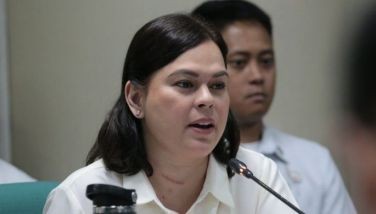Banks’ credit card receivables up to P86.5B in Q3
December 19, 2006 | 12:00am
Delinquent credit card receivables (CCRs) are steadily rising but the increase in the use of plastic money has allowed banks to keep the ratios almost unchanged from the previous year.
Data from the Bangko Sentral ng Pilipinas (BSP) indicated that credit card spending went up 13.6 percent to P86.5 billion in the third quarter from P76.1 billion a year ago.
In the second quarter, CCRs amounted to P81.9 billion.
According to the BSP, the proportion of CCRs to the combined total loan portfolio (TLP) of universal/commercial banks (U/KBs) and thrift banks (TBs) was recorded at 4.7 percent, higher than 4.5 percent last quarter and 4.4 percent last year.
The BSP said that based on bank reports, the bulk of these receivables were generally current in status, except for some P16.7 billion that were past due. This is equivalent to 19.3-percent of total receivables, only slightly higher than the 19.2 percent total in the last quarter and better than the 19.4-percent ratio last year.
In terms of absolute amount, however, the past due receivables in the third quarter was higher than P15.7 billion recorded at the end of the first semester.
The improvement in ratio, however, was driven by the growth in CCRs and although banks also reported that they were able to contain past-due CCRs in the two comparative quarters.
The P16.7-billion past due CCRs represented nine percent of the total non-performing loans of both U/KBs/TBs, compared with 8.5 percent in the first semester and 6.1 percent in the same quarter last year.
The U/KBs (bank proper) still had the biggest exposures at 72- percent share of total CCRs. Credit card subsidiaries of U/KBs followed with a 24.4 percent share of total CCRs, and the stand-alone TBs held the balance of 3.6 percent.
These numbers mean that more credit card holders are having difficulties settling their credit card payments and these delinquent holders are habitual, with past due accounts lasting over six months and more.
As interest rates continued to slide, the BSP has indicated that credit card issuers should cap their annual rates at 18 to 20 percent or risk legislative intervention amid consumer lobby to make credit card loans cheaper.
The BSP expressed concern that credit card rates were failing to adjust to market forces to the detriment of consumers using plastic currency, saying there was a disjoint between prevailing interest rates and the effective rates on credit card loans.
On the average, consumers end up paying a compounded interest rate of 35 to 40 percent a year, including the basic interest rate, fees and charges.
BSP Governor Amando M. Tetangco Jr. said credit card issuers should either take the initiative to reduce the cost to consumers or wait for Congress to step in and legislate.
"If Congress steps in, that’s going to be even harder for the industry to deal with," he said.
Data from the Bangko Sentral ng Pilipinas (BSP) indicated that credit card spending went up 13.6 percent to P86.5 billion in the third quarter from P76.1 billion a year ago.
In the second quarter, CCRs amounted to P81.9 billion.
According to the BSP, the proportion of CCRs to the combined total loan portfolio (TLP) of universal/commercial banks (U/KBs) and thrift banks (TBs) was recorded at 4.7 percent, higher than 4.5 percent last quarter and 4.4 percent last year.
The BSP said that based on bank reports, the bulk of these receivables were generally current in status, except for some P16.7 billion that were past due. This is equivalent to 19.3-percent of total receivables, only slightly higher than the 19.2 percent total in the last quarter and better than the 19.4-percent ratio last year.
In terms of absolute amount, however, the past due receivables in the third quarter was higher than P15.7 billion recorded at the end of the first semester.
The improvement in ratio, however, was driven by the growth in CCRs and although banks also reported that they were able to contain past-due CCRs in the two comparative quarters.
The P16.7-billion past due CCRs represented nine percent of the total non-performing loans of both U/KBs/TBs, compared with 8.5 percent in the first semester and 6.1 percent in the same quarter last year.
The U/KBs (bank proper) still had the biggest exposures at 72- percent share of total CCRs. Credit card subsidiaries of U/KBs followed with a 24.4 percent share of total CCRs, and the stand-alone TBs held the balance of 3.6 percent.
These numbers mean that more credit card holders are having difficulties settling their credit card payments and these delinquent holders are habitual, with past due accounts lasting over six months and more.
As interest rates continued to slide, the BSP has indicated that credit card issuers should cap their annual rates at 18 to 20 percent or risk legislative intervention amid consumer lobby to make credit card loans cheaper.
The BSP expressed concern that credit card rates were failing to adjust to market forces to the detriment of consumers using plastic currency, saying there was a disjoint between prevailing interest rates and the effective rates on credit card loans.
On the average, consumers end up paying a compounded interest rate of 35 to 40 percent a year, including the basic interest rate, fees and charges.
BSP Governor Amando M. Tetangco Jr. said credit card issuers should either take the initiative to reduce the cost to consumers or wait for Congress to step in and legislate.
"If Congress steps in, that’s going to be even harder for the industry to deal with," he said.
BrandSpace Articles
<
>
- Latest
- Trending
Trending
Latest


























